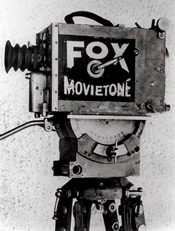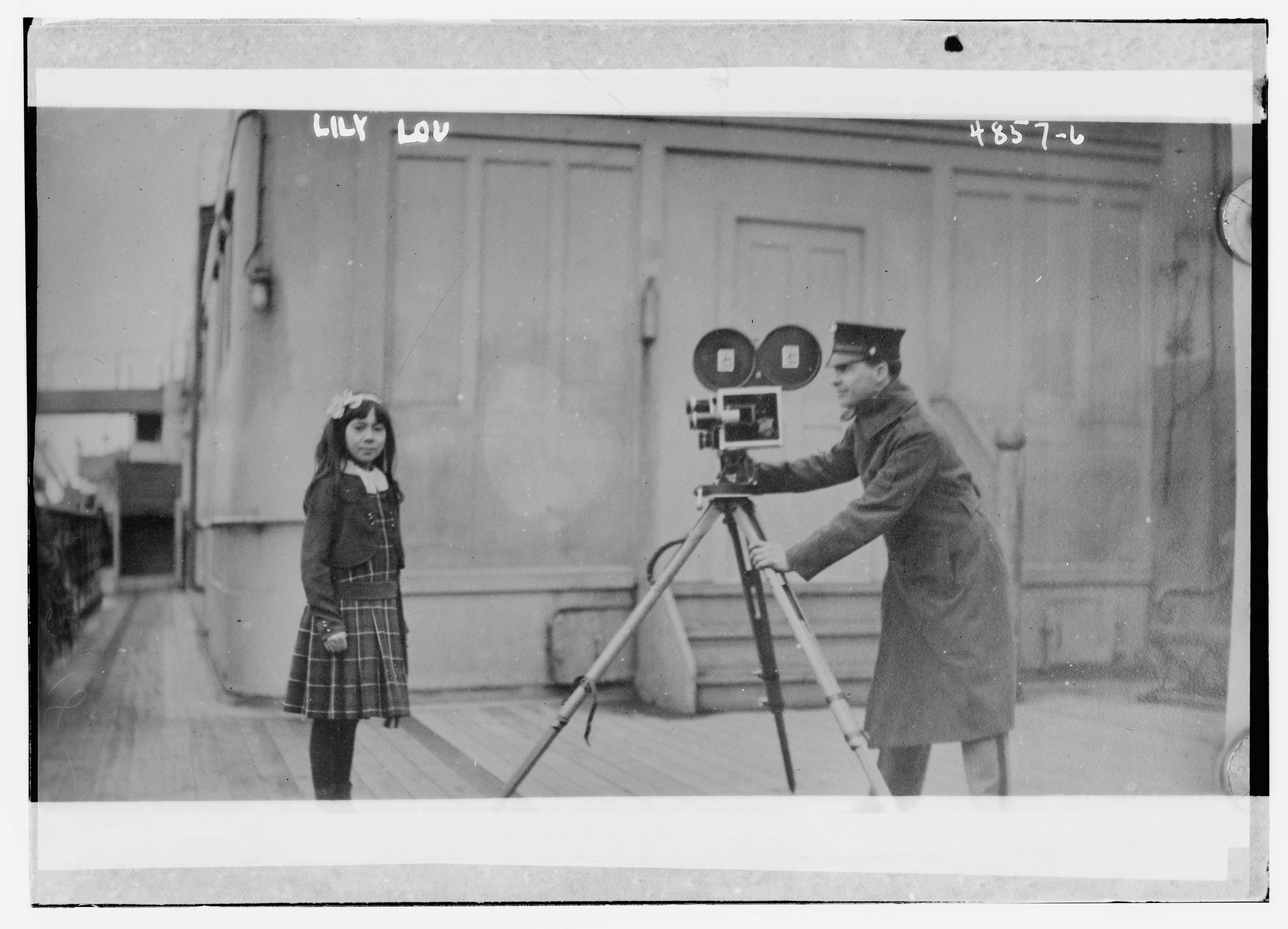|
Movietone Sound System
The Movietone sound system is an optical sound-on-film method of recording sound for motion pictures that guarantees synchronization between sound and picture. It achieves this by recording the sound as a variable-density optical track on the same strip of film that records the pictures. The initial version was capable of a frequency response of 8500 Hz. Although sound films today use variable-area tracks, any modern motion picture theater (excluding those that have transitioned to digital cinema) can play a Movietone film without modification to the projector (though if the projector's sound unit has been fitted with red LED or laser light sources, the reproduction quality from a variable density track will be significantly impaired). Movietone was one of four motion picture sound systems under development in the U.S. during the 1920s, the others being DeForest Phonofilm, Warner Brothers' Vitaphone, and RCA Photophone, though Phonofilm was primarily an early version of Movietone. ... [...More Info...] [...Related Items...] OR: [Wikipedia] [Google] [Baidu] |
Optical Sound
Optical sound is a means of storing sound recordings on transparent film. Originally developed for military purposes, the technology first saw widespread use in the 1920s as a sound-on-film format for motion pictures. Optical sound eventually superseded all other sound film technologies until the advent of digital sound became the standard in cinema projection booths. Optical sound has also been used for multitrack recording and for creating effects in some musical synthesizers. 1914-1921: Naval and military use Building on the principle first demonstrated by the Photophone of Alexander Graham Bell in 1880, optical sound was developed by several inventors with an interest in wireless communication through transmission of light, primarily for ship-to-ship use. The idea was that sound pulses could be converted into light pulses, beamed out from one ship and picked up by another, where the light pulses would then be reconverted into sound. A pioneer in this technology was Am ... [...More Info...] [...Related Items...] OR: [Wikipedia] [Google] [Baidu] |
Academy Ratio
The Academy ratio of 1.375:1 (abbreviated as 1.37:1) is an aspect ratio of a frame of 35 mm film when used with 4-perf pulldown.Monaco, James. ''How to Read a Film: The Art, Technology, Language, History and Theory of Film and Media''. Rev. ed. New York: Oxford University Press, 1981. .Bordwell, David and Thompson, Kristin. ''Film Art: An Introduction''. Rev. ed. New York: McGraw-Hill, 1993. . It was standardized by the Academy of Motion Picture Arts and Sciences as the standard film aspect ratio in 1932, although similar-sized ratios were used as early as 1928. History Silent films were shot at a 1. aspect ratio (also known as a 4:3 aspect ratio), with each frame using all of the negative space between the two rows of film perforations for a length of 4 perforations. The frame line between the silent film frames was very thin. When sound-on-film was introduced in the late 1920s, the soundtrack was recorded in a stripe running just inside one set of the perforations ... [...More Info...] [...Related Items...] OR: [Wikipedia] [Google] [Baidu] |
35mm Movie Film
35 mm film is a film gauge used in filmmaking, and the film standard. In motion pictures that record on film, 35 mm is the most commonly used gauge. The name of the gauge is not a direct measurement, and refers to the nominal width of the 35 mm format photographic film, which consists of strips wide. The standard image exposure length on 35 mm for movies ("single-frame" format) is four perforations per frame along both edges, which results in 16 frames per foot of film. A variety of largely proprietary gauges were devised for the numerous camera and projection systems being developed independently in the late 19th century and early 20th century, as well as a variety of film feeding systems. This resulted in cameras, projectors, and other equipment having to be calibrated to each gauge. The 35 mm width, originally specified as inches, was introduced around 1890 by William Kennedy Dickson and Thomas Edison, using 120 film stock supplied by George E ... [...More Info...] [...Related Items...] OR: [Wikipedia] [Google] [Baidu] |
SMPTE
The Society of Motion Picture and Television Engineers (SMPTE) (, rarely ), founded in 1916 as the Society of Motion Picture Engineers or SMPE, is a global professional association of engineers, technologists, and executives working in the media and entertainment industry. As an internationally recognized standards organization, SMPTE has published more than 800 technical standards and related documents for broadcast, filmmaking, digital cinema, audio recording, information technology (IT), and medical imaging. SMPTE also publishes the ''SMPTE Motion Imaging Journal'', provides networking opportunities for its members, produces academic conferences and exhibitions, and performs other industry-related functions. SMPTE membership is open to any individual or organization with an interest in the subject matter. In the US, SMPTE is a 501(c)3 non-profit charitable organization. History The Motion Picture and Television Engineers was founded in 1913 by Charles Francis Jenkins, w ... [...More Info...] [...Related Items...] OR: [Wikipedia] [Google] [Baidu] |
Fox Movietone 2
Foxes are small to medium-sized, omnivorous mammals belonging to several genera of the family Canidae. They have a flattened skull, upright, triangular ears, a pointed, slightly upturned snout, and a long bushy tail (or ''brush''). Twelve species belong to the monophyletic "true foxes" group of genus ''Vulpes''. Approximately another 25 current or extinct species are always or sometimes called foxes; these foxes are either part of the paraphyletic group of the South American foxes, or of the outlying group, which consists of the bat-eared fox, gray fox, and island fox. Foxes live on every continent except Antarctica. The most common and widespread species of fox is the red fox (''Vulpes vulpes'') with about 47 recognized subspecies. The global distribution of foxes, together with their widespread reputation for cunning, has contributed to their prominence in popular culture and folklore in many societies around the world. The hunting of foxes with packs of hounds, long an es ... [...More Info...] [...Related Items...] OR: [Wikipedia] [Google] [Baidu] |
Movietone News
Movietone News is a newsreel that ran from 1928 to 1963 in the United States. Under the name British Movietone News, it also ran in the United Kingdom from 1929 to 1986, in France also produced by Fox-Europa, in Australia and New Zealand until 1970, and Germany as Fox Tönende Wochenschau. History Movietone News evolved from an earlier newsreel established by Fox Films called Fox News which was founded in 1919. It produced silent newsreels. When Fox entered talkies in 1928 with '' Mother Knows Best'', the name Fox Movietone was applied to Fox's sound productions. In the U.S. as Fox Movietone News it produced cinema, sound newsreels from 1928 to 1963, and from 1929 to 1986 in the UK (for much of that time as British Movietone News), as well as 1929 to 1975 in Australia. One of the earliest in the series featured ''George Bernard Shaw Talks to Movietone News'', released on June 25, 1928. One of the known early producers of these newsreels was Abraham Harrison also known as Harry, ... [...More Info...] [...Related Items...] OR: [Wikipedia] [Google] [Baidu] |
Western Electric
The Western Electric Company was an American electrical engineering and manufacturing company officially founded in 1869. A wholly owned subsidiary of American Telephone & Telegraph for most of its lifespan, it served as the primary equipment manufacturer, supplier, and purchasing agent for the Bell System from 1881 to 1984 when it was dismantled. The company was responsible for many technological innovations as well as developments in industrial management. History In 1856, George Shawk, a craftsman and telegraph maker, purchased an electrical engineering business in Cleveland, Ohio. In January, 1869, Shawk had partnered with Enos M. Barton in the former Western Union repair shop of Cleveland, to manufacture burglar, fire alarms, and other electrical items. Both men were former Western Union employees. Shawk, was the Cleveland shop foreman and Barton, was a Rochester, New York telegrapher. During this Shawk and Barton partnership, one customer was an inventor sourcing parts and ... [...More Info...] [...Related Items...] OR: [Wikipedia] [Google] [Baidu] |
Mother Knows Best (1928 Film)
''Mother Knows Best'' is a 1928 American film directed by John G. Blystone, based on a novel by Edna Ferber, fictionalizing the life of vaudevillian Elsie Janis. The film was Fox's first part talkie, using the Movietone sound system which had primarily been used for synchronised music scores and effects tracks in Fox features beforehand, although as early as " Mother Machree" (1928), a single synchronous singing sequence was included in the film. The sound sections in ''Mother Knows Best'' were directed by actor Charles Judels, whilst the silent sequences were directed by John G. Blystone. The film starred Madge Bellamy, with Louise Dresser as her domineering mother, Barry Norton, and Albert Gran.Michael G. Ankerich ''Broken silence: conversations with 23 silent film stars'' 1993 p.52 "After her contract was up in 1924, she was immediately signed to a four-year contract with Fox Pictures, ... Madge made her talkie debut as the star of Fox's first real dialogue picture, Mother Kno ... [...More Info...] [...Related Items...] OR: [Wikipedia] [Google] [Baidu] |
A Song Of Two Humans
A, or a, is the first letter and the first vowel letter of the Latin alphabet, used in the modern English alphabet, and others worldwide. Its name in English is '' a'' (pronounced ), plural ''aes''. It is similar in shape to the Ancient Greek letter alpha, from which it derives. The uppercase version consists of the two slanting sides of a triangle, crossed in the middle by a horizontal bar. The lowercase version is often written in one of two forms: the double-storey and single-storey . The latter is commonly used in handwriting and fonts based on it, especially fonts intended to be read by children, and is also found in italic type. In English, '' a'' is the indefinite article, with the alternative form ''an''. Name In English, the name of the letter is the ''long A'' sound, pronounced . Its name in most other languages matches the letter's pronunciation in open syllables. History The earliest known ancestor of A is ''aleph''—the first letter of the Phoenician ... [...More Info...] [...Related Items...] OR: [Wikipedia] [Google] [Baidu] |
Earl I
Earl () is a rank of the nobility in the United Kingdom. The title originates in the Old English word ''eorl'', meaning "a man of noble birth or rank". The word is cognate with the Scandinavian form ''jarl'', and meant "chieftain", particularly a chieftain set to rule a territory in a king's stead. After the Norman Conquest, it became the equivalent of the continental count (in England in the earlier period, it was more akin to a duke; in Scotland, it assimilated the concept of mormaer). Alternative names for the rank equivalent to "earl" or "count" in the nobility structure are used in other countries, such as the ''hakushaku'' (伯爵) of the post-restoration Japanese Imperial era. In modern Britain, an earl is a member of the peerage, ranking below a marquess and above a viscount. A feminine form of ''earl'' never developed; instead, ''countess'' is used. Etymology The term ''earl'' has been compared to the name of the Heruli, and to runic ''erilaz''. Proto-Norse ''eri ... [...More Info...] [...Related Items...] OR: [Wikipedia] [Google] [Baidu] |
Tri-Ergon
The Tri-Ergon sound-on-film system was developed from around 1919 by three German inventors, Josef Engl (1893–1942), Joseph Massolle (1889–1957), and Hans Vogt (1890–1979). The system used a photoelectric recording method and a non-standard film size (42mm) which incorporated the sound track with stock 35mm film. With a Swiss backer, the inventors formed Tri-Ergon AG in Zurich, and tried to interest the market with their invention. Ufa acquired the German sound film rights for the Tri-Ergon process in 1925, but dropped the system when the public showing of their first sound film suffered technical failures. The Tri-Ergon system appeared at a time when a number of other sound film processes were arriving on the market, and the company soon merged with a number of competitors to form the Tobis syndicate in 1928, joined by the Klangfilm AG syndicate in 1929 and renamed as Tobis-Klangfilm by 1930. While Tri-Ergon became the dominant sound film process in Germany and much of ... [...More Info...] [...Related Items...] OR: [Wikipedia] [Google] [Baidu] |
Freeman Harrison Owens
Freeman Harrison Owens (July 20, 1890 – December 9, 1979) was an early American filmmaker and aerial photographer. Biography was born in Pine Bluff, Arkansas, the only child of Charles H. Owens and Christabel Harrison. He attended Pine Bluff High School in Pine Bluff, but quit in his senior year to work at a local movie theatre as a projectionist. Owens constructed his own 35mm movie camera at the age of 16. He filmed early newsreels, such as the Chicago Union Stock Yards Fire in December 1910 and the Charleston, South Carolina hurricane and flood in August 1911. He served during World War I as a photographer, helping progress the art of aerial photography for combat purposes. He filmed the famous Joe Stecher vs. Earl Caddock wrestling match at Madison Square Garden on January 30, 1920. His last credit as cinematographer was '' Love's Old Sweet Song'' (1923), filmed in the Lee DeForest Phonofilm process, and starring Donald Gallaher, Louis Wolheim, and Una Merkel. ... [...More Info...] [...Related Items...] OR: [Wikipedia] [Google] [Baidu] |







